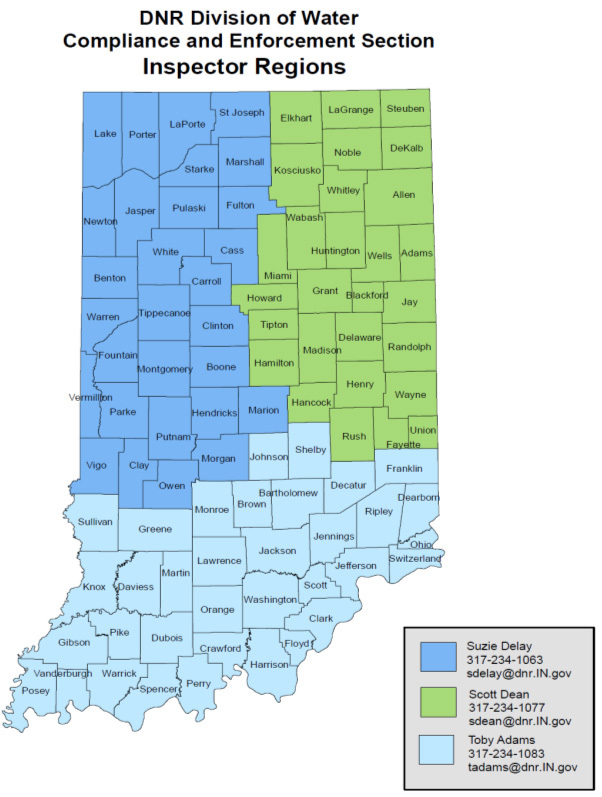 Elevated Structure
By Doug Wagner, Division of Water
Floodplain administrators are faced with permitting, inspecting and approving all kinds of structures within the Special Flood Hazard Areas (SFHAs) of their communities. One of these structures may be an “elevated structure.”
What is an elevated structure?
By definition, in most local ordinances “elevated structure” means a non-basement structure built to have the lowest floor elevated above the ground level by means of fill, solid foundation perimeter walls, filled stem wall foundations (also called chain walls), pilings, or columns (post or piers.)
In the first portion of the definition, we notice it states “non-basement” structure. Then, what is considered a basement? A basement is considered any portion of a structure that is subgrade (below ground level) on all sides. This becomes very important when considering flood insurance premiums, since structures with basements will typically have significantly higher premiums. The key here is to have the floor level of any enclosure below an elevated structure at or above the adjacent grade on at least one side of the structure. Most property owners can meet this requirement when retrofitting or elevating existing structures with the placement of fill within the enclosure area.
Local officials must be mindful of this requirement also when a property owner is completing new construction or substantially improving an existing structure on a subgrade crawlspace. The reason for this is subgrade crawlspaces are treated like basements for flood insurance rating purposes. If a property is determined to be in the SFHA and the owner obtains an Elevation Certificate that reveals the lowest floor is below the Base Flood Elevation (BFE) the structure’s premium would be rated with the lowest floor and considered a basement.
When considering pre-firm homes that are elevated due to either a substantial improvement or suffering substantial damage, the local administrator must look at other aspects of the construction methods and materials used when enclosures are allowed. These structures must be carefully looked at when determining if they are in compliance with the National Flood Insurance Program (NFIP). The local inspector, surveyor, or other professional will need to determine if the materials used below the Flood Protection Grade (FPG) are flood resistant in accordance with Technical Bulletin 2. This requirement applies to the wall construction and any equipment that may be placed within the enclosure below FPG. The enclosure may only be used for parking, storage of low value items, and building access. These areas should be limited to the least extent possible and also preclude any habitable or finished area. Any enclosures must be properly vented in accordance with the requirements of Technical Bulletin 1. The primary venting requirements are that at least one vent is placed on two different sides of the structure and they have a total net area of one square inch for each square foot of the enclosure.
We have only highlighted the primary requirements of elevated structures in this article. For a more detailed description of elevated structures, consult FEMA's Library. Some helpful publications are: Above the Flood, Elevating Your Floodprone House, Elevated Residential Structures, Homeowners Guide to Retrofitting, Protecting Building Utility Systems from Flooding, and Protecting Manufactured Homes from Floods and Other Hazards.
Compliance and Enforcement welcomes Scott Dean

Scott will serve as the compliance and enforcement case manager for Northeastern Indiana. Most of the counties that are now assigned to Scott were previously covered by Suzie Delay, and a few were with Toby Adams. Please see the attached map that shows our territories.
Scott has been with the Division of Water since 2008, where he started his career in the Resource Assessment section mapping the state's aquifer systems. In 2012, he transferred to the Technical Services section, where he handled regulatory permitting for the North Basin.
He received his Bachelor of Arts degree from Indiana University-Purdue University Indianapolis in Geographic Information Science. When not assisting Hoosiers, he enjoys spending time with family and friends, traveling, cooking, hiking, and helping with his son’s hockey team.
|

Incomplete Permit Application Policy
By Doug Wagner, Division of Water
On June 29 the Department of Natural Resources Division of Water sent out notice to all agents that had filed permit applications over the last year. That notice detailed the implementation of our new policy regarding permit applications filed with the Division.
In an effort to streamline and expedite the permit process, the Division will only allow seven days from the date of application for an applicant or agent to submit the required supporting documentation necessary to fully process the request. This requirement became effective on July 1, 2020.
After an analysis of our permit applications was completed, it was shown that approximately 40% of all applications were deficient upon receipt. We also noticed that it took an average of 30 days for all required supporting documentation to be submitted. Since the applications are not assigned until all required documentation is received, this only increased the length of time to process these permit applications.
To avoid the denial of an application, an applicant should only submit an application when they have all supporting documentation prepared and can submit to the Division within the seven-day requirement.
Public notice is still a required part of permit applications and can only be completed once the applicant/agent receives the permit application number or permit acknowledgement notice. The public notice is not included in the seven-day time period. Applicants are urged to complete it as soon as possible upon receipt of their application number or acknowledgement notice. Delays in submitting the notice affidavit will only further delay the complete processing of the application.
TRAINING OPPORTUNITY

(Information from FEMA, ASFPM, and other websites)
Association of State Floodplain Managers (ASFPM)
ASFPM has an online training program, and training is added regularly. See https://www.floods.org/training-knowledge-center/ for more information.
FEMA’s Emergency Management Institute (EMI)
In light of the COVID-19 pandemic EMI has suspended all on campus and instructor led courses through at least Oct. 1, 2020.
EMI also offers many courses through webinar training opportunities. For additional information on EMI classes and webinars, please visit EMI’s training calendar website at https://training.fema.gov/emicourses/schedules.aspx and its course catalog at https://www.firstrespondertraining.gov/frt/npccatalog/EMI.
Other Trainings and Conferences
Indiana Association for Floodplain and Stormwater Management (INAFSM) Conference: The INAFSM Conference scheduled for Sept. 16-18, 2020 will be held virtually! The conference will include both recorded and live sessions. All sessions will become available after the event with approximately 30 professional development hours. Early bird registration is $100 for members and $150 for non-members through Aug. 14. Registration from Aug. 15 to Sept.14 is $140 for members and $190 for non-members. This will be an excellent training opportunity for Floodplain Administrators and other local officials to expand their floodplain and stormwater knowledge bank since there is no travel or lodging expenses for the event. For further details on the event or to register go to https://www.inafsm.net/2020-virtual-annual-conference.
STATE TRAINING OPPORTUNITIES
CFM EXAM OFFERING – Oct. 1, 2020
Are you ready to be Indiana’s next Certified Floodplain Manager (CFM)?
The DNR Division of Water will again proctor the CFM exam on Thursday, Oct. 1, at the Indiana Government Center South in Indianapolis (Conference Room 22) at 9 a.m. A short instructional session will be held at the INAFSM virtual conference about two weeks prior.
To take the CFM exam, you must complete and submit the CFM Program Application Package to the Association of State Floodplain Managers (ASFPM). The forms are available on the ASFPM website, floods.org, under the Certification Program tab. The fee is $100 for ASFPM members and $480 for non-members.
You may submit an application for ASFPM membership at the same time you apply to take the exam. To be accepted to take the exam at this scheduled time, you must submit your completed application and pay the appropriate fee to ASFPM by Sept. 25. No walk-ins will be allowed unless authorized by the ASFPM executive office. For further information about the exam, contact Doug Wagner at dwagner1@dnr.IN.gov.
Virtual Workshops – Sept. 2020
The Floodplain Management Section will be offering two, one hour workshops on Sept. 10, 22, 24, and 29, 2020. The workshops will be “Inspecting Potential Non-compliant Development and Giving Notices” and “Meeting with Property Owners and Resolving Non-compliant Issues.” The workshops will be held at 9 a.m. and 2 p.m. on each of the days listed and will alternate between the morning and afternoon time to provide additional opportunities for prospective attendees.
Indiana Department of Homeland Security
Please visit the Indiana Department of Homeland Security’s training calendar for upcoming courses and trainings at https://oas.dhs.in.gov/hs/training/public/calendar.do
|
UPDATES TO TECHNICAL BULLETIN 4:
Elevator Installation for Buildings Located in Special Flood Hazard Areas in Accordance with the National Flood Insurance Program
By Doug Wagner, Division of Water
Elevator use in both residential and nonresidential buildings has increased substantially since the passage of the Americans with Disabilities Act of 1990. The efforts to make buildings accessible under the act has become more difficult, adding further requirements or considerations that we must follow when a structure is located in a Special Flood Hazard Area (SFHA). Technical Bulletin 4 (TB-4) was updated in June of 2019 to better assist local officials, property owners, and other professionals in determining compliance of elevators and other lifting devices when installed in a SFHA.
The first of the updates was the expanded discussion on the primary types of elevators and other conveyance mechanisms used in residential and nonresidential buildings. These devices include hydraulic, traction, and pneumatic-type elevators, chair lifts, and platform lifts. Next, the definition of “basement” was further clarified as it relates to the construction of elevator pits. Expanded tables and additional diagrams were added or updated to summarize elevator system components, their physical location, and recommended flood protection techniques.
When considering the installation of an elevator or other lifting device in a structure located in the SFHA, you would first want to look at the effects on your National Flood Insurance Program (NFIP) policy premium. The way in which the device is installed or the type of device used can impact your policy premium. This may also lead to a need for local officials, engineers, and surveyors to reach out for other professional services to determine if the lifting device and associated components are in compliance with the community’s flood hazard ordinance. One example would be the lowest elevation of machinery or equipment for a surveyor completing an Elevation Certificate (EC) or local building official doing a site inspection. The surveyor may be able to determine the elevation of the lowest equipment, but both may be unfamiliar with what portions of the equipment are considered flood resistant or are not required to be elevated under the NFIP.
In “A” zones, all enclosures are considered basements when they are subgrade on all sides. When considering elevator pits that may be required for some elevators, if subgrade there may be a premium surcharge (loading) for the subgrade pit, but it may not be considered a basement for rating purposes as long as it meets other requirements under the NFIP.
Another zone “A” requirement is venting for above grade enclosures. This also applies to an elevator enclosure/shaft and would waive the premium surcharge if properly vented. In “V” zones enclosures must be less than 300 square feet in area and be constructed with “break-away” walls. If constructed in this manner there is no premium loading. If the enclosure is greater than 300 square feet or does not have “break away” walls, the premium surcharges or loading would be applied based on the square footage of the enclosure. In “V” zones elevator shafts are not required to be constructed with “break away” walls if they are the minimum size necessary to allow access to the structure. Other protection measures such as float switches that prevent elevator cabs from entering flood waters or terminating operation during a flood event are recommended in all SFHAs.
There have been several updates to the Technical Bulletin overall, many of which have just been briefly touched on within this article. A complete copy of the updated TB 4 can be downloaded here: Technical Bulletins.
UPDATES TO TECHNICAL BULLETIN 8:
Corrosion Protection for Metal Connectors and Fasteners in Coastal Areas
By Jerod Evans, Division of Water
Imagine you have a lovely beach front property. The water is crashing up against the beach spraying a cool mist into the air, catching the light in just the right way to form a prism of color. This natural display of beauty is breathtaking. Yet, the mist that is creating this spectacle could be making the house less structurally sound. This corrosive damage caused by higher moisture and humidity levels can weaken the metal fixtures and supports if they are not properly galvanized. This corrosion can also occur on structures with treated lumber due to the metals and chemicals that are used to treat the wood. Knowing what kind of galvanized metal to use and all the regulations can be tedious. However, all of this is well summed up in FEMA Technical Bulletin 8 (TB 8).
As a brief overview, TB 8 speaks of loadbearing and load paths, which are essentially how a structure distributes its own weight and external forces, such as flooding or wind, which can act upon it. The metal connectors that help distribute these forces or loads can be corroded, making the structures more susceptible to failure. This is why there are National Flood Insurance Program (NFIP) regulations that are discussed in this article which cite the Code of Federal Regulations (CFR) Chapter 44 Sections 60.3(a)(3) and 60.3(e)(4) as their authority. The International Building Code (IBC), International Residential Code (IRC), and the American Society of Civil Engineers (ASCE) requirements, which meet or exceed NFIP requirements, are also noted in this bulletin. They are broken down in an easy to read table which compare these standards to NFIP standards, while also pointing out changes in the requirements in recent time. TB 8 then breaks down all of the factors that can contribute to corrosive damage to metal connectors. The technical bulletin has a great deal of detail, even going into why zinc is used in the galvanization process, and has recently received updates.
These updates include further details about connectors/fasteners and how to choose the correct ones for the given environments to which they will be installed. One of the updates in this technical bulletin expound upon the difference in coatings on the materials, noting how they interact with their environment and how using dissimilar metals near one another can have corrosive consequences. Even more updates outline the applications of metal coatings, maintenance, and inspections of the metal connectors that one would be using on their structure, and of course how the use of treated lumber should always be accompanied by identifying the wood product identification tag to see if your lumber is compatible with the fasteners or connectors you might want to use.
The FEMA Technical Bulletin 8 has a wealth of good information about load paths and how to better equip your home for long term structural stability by staving off the effects of corrosion. Additionally, the updates that have come out for the bulletin have made it even more specific, making it all the greater resource if you are building a home or just doing maintenance. The updated copy of FEMA TB 8 can be downloaded at FEMA’s website found here: Technical Bulletins.
THANK YOU
Thanks to those contributing to this issue: Ryan Mueller, George Bowman, Anita Nance, Darren Pearson, Wanda Gaines, Jerod Evans, Scott Dean, Marty Benson, Don Kaczorowski, and Ed Reynolds.
Editor – Doug Wagner
The work that provides the basis for this newsletter was supported by funding under a cooperative agreement with the Federal Emergency Management Agency. The author and publisher are solely responsible for the accuracy of the statements and interpretations contained in the publication. Such interpretations do not necessarily reflect the views of the federal government.
Waterlines is produced quarterly as a public service by the DNR Division of Water.
Waterlines is available on the web at dnr.IN.gov/water.

Having trouble viewing this email? View it as a Web page.
|